Buffeted by gusts as I stood on the windswept headland staring out at the white-tipped waves of the wild North Sea, I had no idea what to expect. It is unusual for me to head off on holiday with my camera in tow without researching what I might be able to photograph. But that wasn’t the point of this trip – it was a family holiday, an opportunity to unwind together, and I wasn’t about to make it about going on the hunt for wildlife photography opportunities.
That said, I knew that opportunities would present themselves. The Northumberland Coast Path hugs the stunning coastline for 62 miles – from Cresswell in the south to Berwick-upon-Tweed in the north. The landscape along the path is constantly changing – from sandy beaches to golf courses, wildflower meadows to coastal dwellings – and is punctuated by dramatic castles and pillboxes occupied by swallows. I expected wildlife, but the variety of insect life there was a pleasant surprise.
Back in Glasgow, before we left for the pretty fishing village of Craster, I had bemoaned the lack of fluttering and buzzing on our walks. Yes, we saw butterflies and bees, but in nowhere near the numbers we would expect for the end of June.
Around seven of every ten species on the planet are invertebrate species. They play many vital roles, including creating nutrient-rich soil through decomposing matter, pollinating plants and flowers and being food for other species. The first thing you read if you visit the Buglife website is a quote:
“If we and the rest of the back-boned animals were to disappear overnight, the rest of the world would get on pretty well. But if the invertebrates were to disappear, the world’s ecosystems would collapse.”
Sir David Attenborough
The lack of insects to photograph on our walks was more than worrying.
However, when we took our first steps onto the Northumberland Coast Path, there was a real buzz about the place. There were bees everywhere, in all shapes and sizes, and butterflies galore. The mix of habitats enabling the species we spotted to thrive, some of which I managed to photograph.
Common blue butterfly
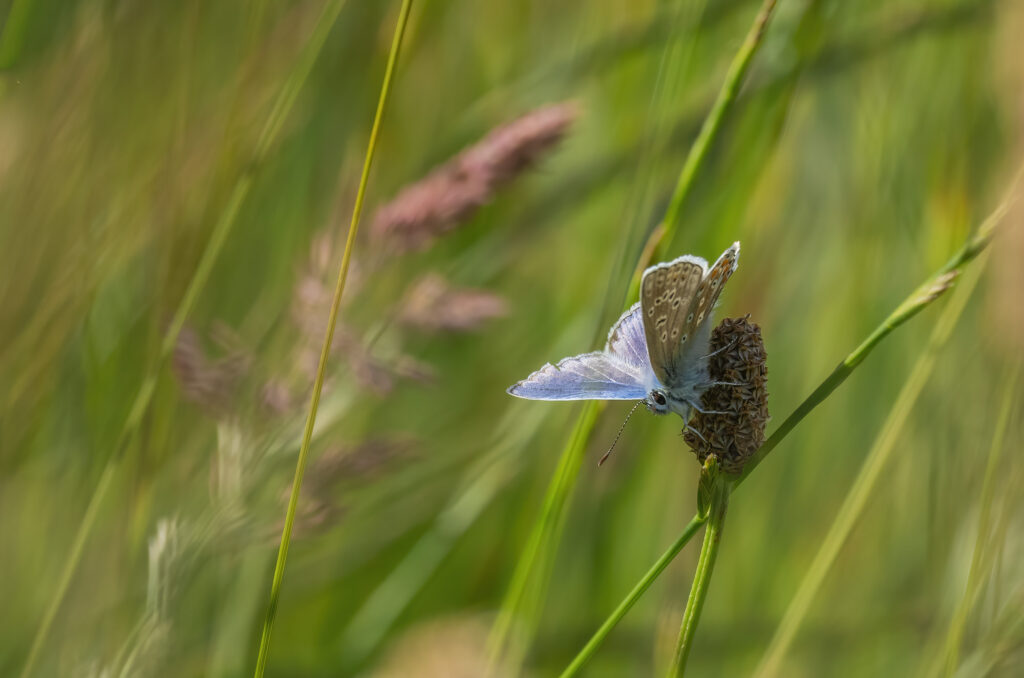
It was a particularly breezy evening when I spotted my first common blue on the path outside Craster. The long grasses remained still for a few seconds before the next gust of wind would send them waving wildly about. These were not ideal conditions to photograph a male common blue butterfly as he clung on. I persevered, as this was a species I hadn’t had the opportunity to photograph before, despite them being as common as their name suggests.
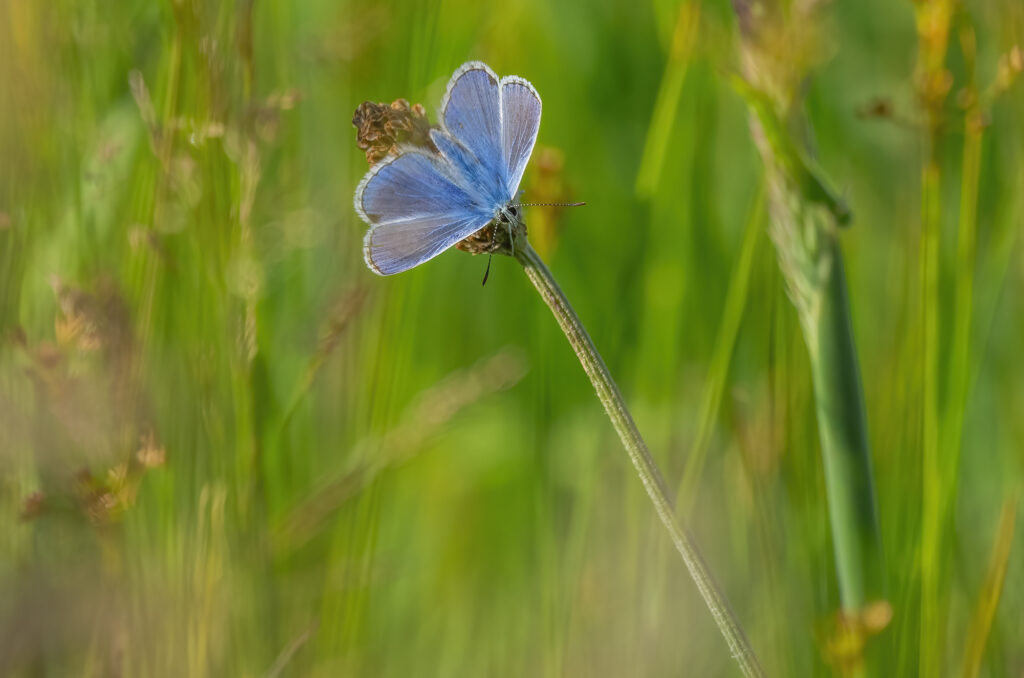
It is at times like these when using back button focus can make all the difference for getting the images you want. In these photos of the common blue, the movement in the grass is shown in the amount of blur in the green areas. Using back button focus enabled me to lock focus on the butterfly, even when the grass was waving in front of it, and press the shutter when it was visible.
Five-spot burnet moth
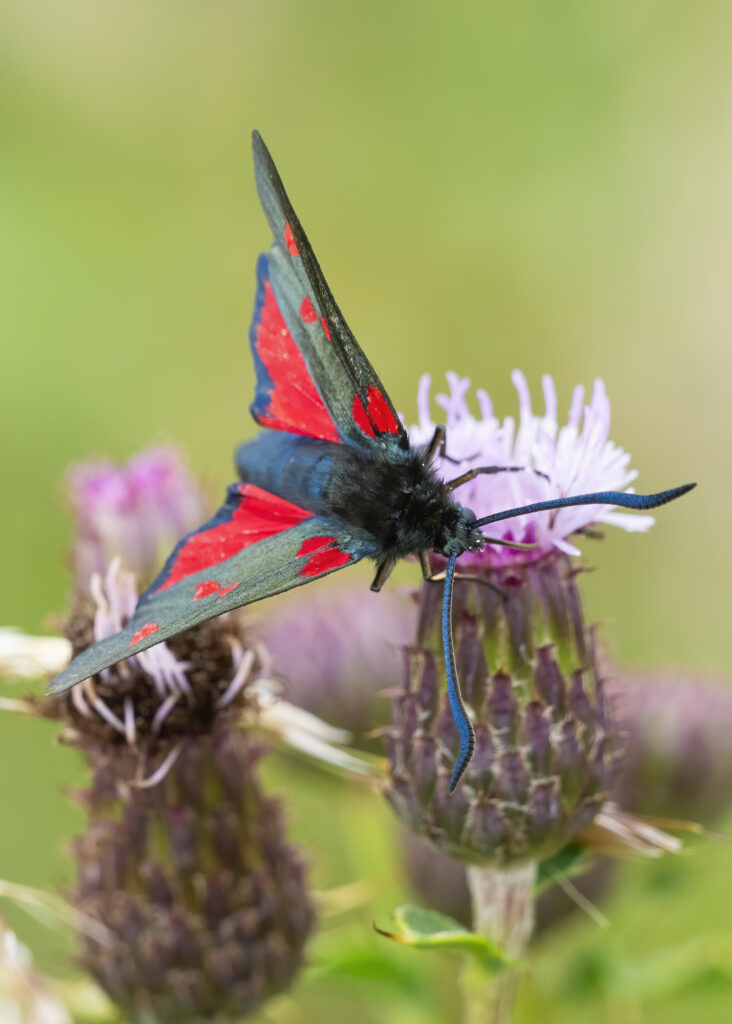
After the common blue’s constant movement, the slow fluttering of the five-spot burnet moth and its frequent stops for nectar was a welcome change of pace. The sun came out after a heavy rain shower and suddenly these day-flying moths were everywhere, soaking up the rays.
Using my long lens (100-400mm) on the OM1 enabled me to stand a good distance away to capture these images, so I avoided disturbing my moth subject. Although this setup doesn’t provide the detail and magnification of a macro lens, it makes it easier to take advantage of invertebrate photography opportunities like this. It also allows me to switch to photographing a passing seabird without needing to change lenses.
As well as making them a bright and bold subject to photograph, the red spots of burnet moths have an important purpose – warning potential attackers that they are poisonous. These moths can release the chemical compound hydrogen cyanide, which gives them a bad taste and, in large quantities, can kill a predator.
Common red soldier beetle
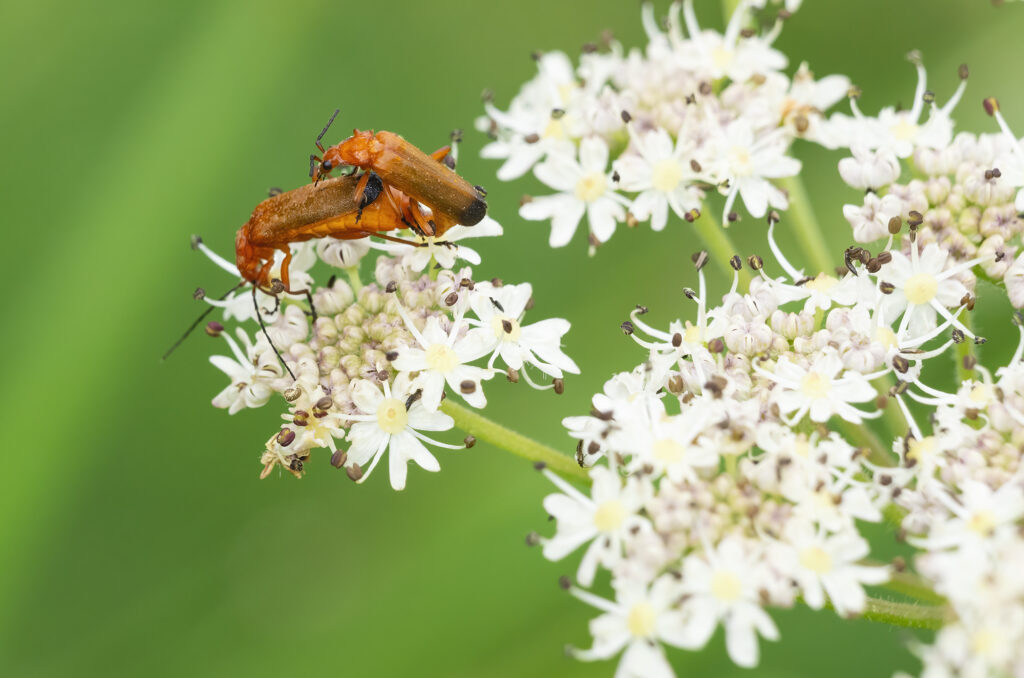
As the weather warmed up, we encountered some often-overlooked exhibitionists. The hogweed ‘bonking beetle’ gets its nickname from the behaviour shown in the image above. There is something quite comical about these beetles – the male looks like he is clinging on for dear life. I had missed seeing these wee beasties on our local walks, so seeing so many on the coast path made me smile.
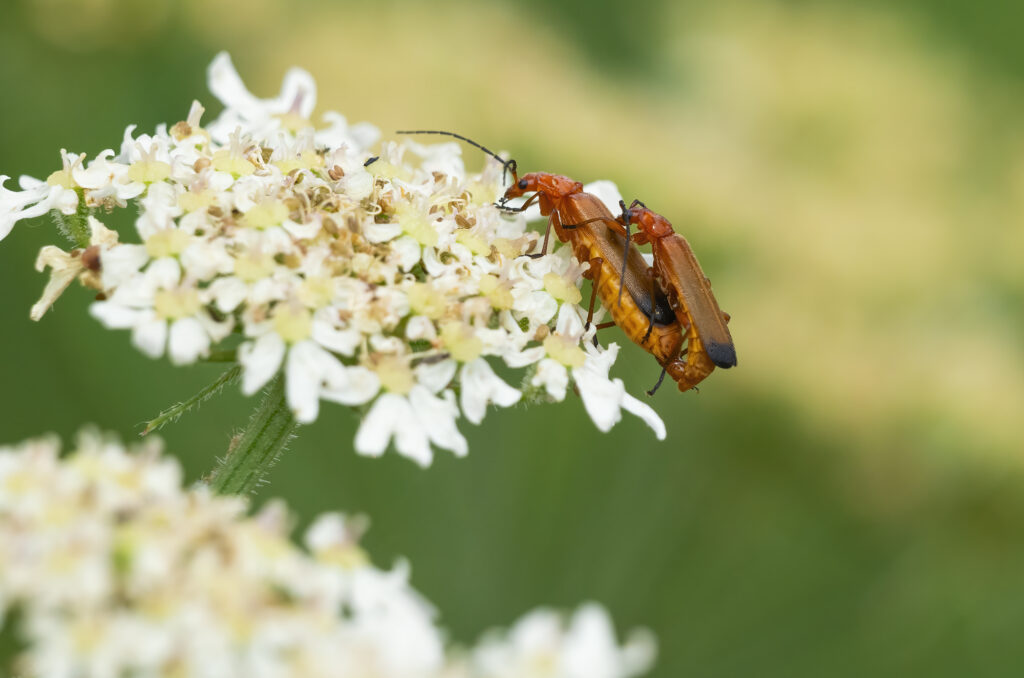
As well as being known as the bonking beetle, the common red soldier beetle is also known as the ‘bloodsucker’ for its striking red appearance, but it is named a ‘soldier’ for its bright red jacket with black marks near the tips of the wing cases. It is also identified by its narrow, rectangular body and longish antennae. However, there are plenty of other soldier beetles in the UK – about 40 species, in fact – with colour combinations of black, red and orange.
Speckled wood butterfly
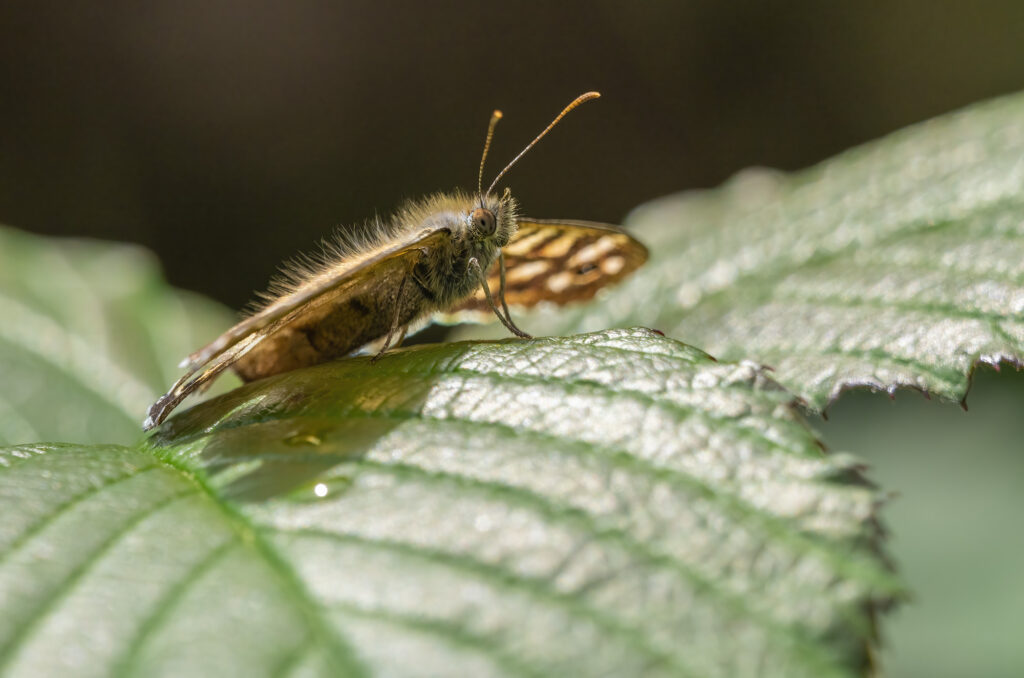
While we had more than our fair share of sunshine on our walks along the coast path, the breeze did blow the occasional shower over us. One rapidly turned into a downpour, drenching us and ensuring that the insects temporarily disappeared. When the sun returned, the path became hotter, and we quickly dried off.
This speckled wood butterfly was sunbathing next to the path after that heavy rain shower, which makes sense. This species seems to prefer slightly damper areas, and this spot was also near a shady area of trees that overhung the path. The speckled wood isn’t a species I have seen in Scotland, so I was happy to spend a few minutes with this lovely butterfly.
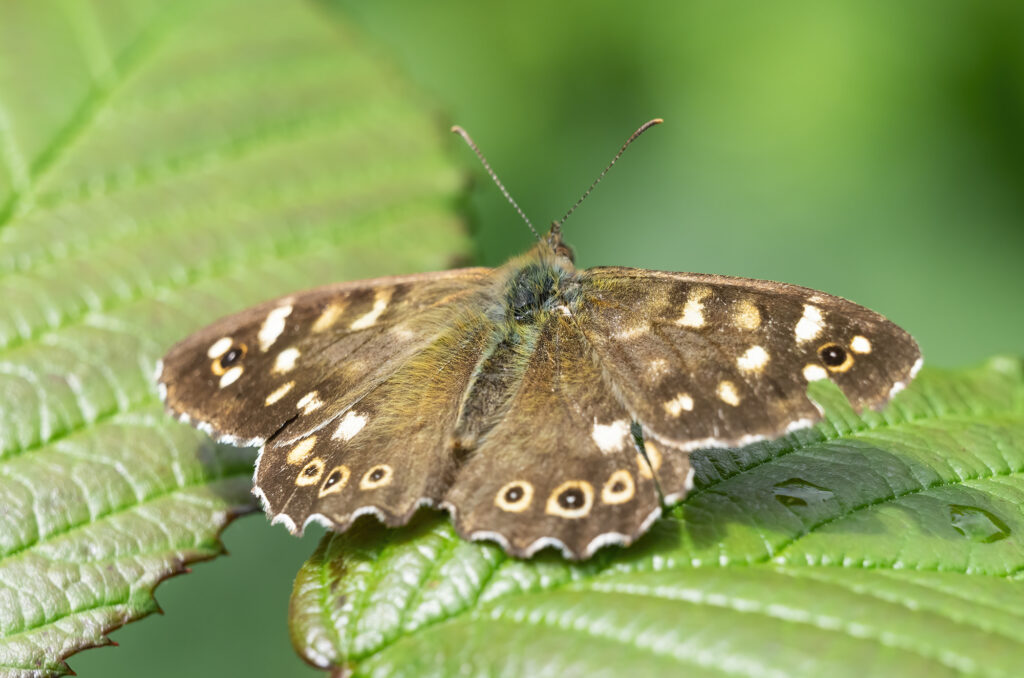
Half of Britain’s butterfly species are already threatened or near threatened with extinction, so we need to collect data to understand how our insects are responding to the changing climate and to take action to protect them. So, if you’re able to take part in the Big Butterfly Count before the 6th of August, please download the app and submit your data. Just taking fifteen minutes out of your day to do this bit of citizen science can help the insects that are counting on us.
I hope the images above show that you don’t need a macro lens and hours of patience to get into photographing invertebrates. Just grab your usual camera and wing it.

